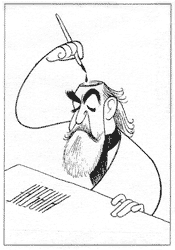 Hirschfeld Has Left the Building
Hirschfeld Has Left the Building
A Tribute to
the Line King
New
York City's Landmarks Conservancy pronounced him a Living Landmark in
1996. Now, alas, he no longer lives. But his drawings do, each one a landmark
of the vibrant purity of his exquisite line art.
"His drawings will last for centuries," said Arthur Gelb, former
managing editor of the New York Times upon hearing of the death,
on January 20 at age 99, of Al Hirschfeld, whose
caricatures in theatrical tableaux had defined the newspaper's Sunday
theater section for decades.
"Like Daumier," Gelb continued, "Hirschfeld's
drawings will be looked at and studied."
If you need to be told that Hirschfeld
was the nation's foremost caricaturist (he preferred "characterist")—that
his sweeping, undulating line is matchless in supple grace and telling
simplicity, that his likenesses of show business personalities and (even)
the stray politician is eerily accurate, that his compositions are playful
interpretations of plays as well as personages—then you haven't
been paying attention for the last seventy-five years.
During most of that period, one name has dominated theatrical caricature
in America. Although in the
popular conception he stands virtually alone these days, Hirschfeld
was the last of a breed that proliferated in the earliest years of the
last century, prospered with the burgeoning of magazine journalism, and
reached an apotheosis in the twenties and thirties, particularly in the
pages of Vanity Fair, which gloried in full-color celebrity caricatures. Hirschfeld emerged
from the pack when he began concentrating on theatrical caricatures for
New York newspapers in 1926, developing his own distinctive style. And for unadulterated flowing economy of
linear expression, no one has ever equaled him. He set the standard. The
Hirschfeld style is The Way to draw show business caricatures.
There is no other way to do it. 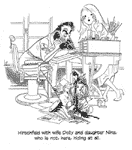
In his portrayal of the cast and ambiance of a stage production
or a movie or a tv show, he achieved symphonic compositions of line, mass,
texture, and shape, masterpieces in black-and-white, and in rendering
action, particularly, his incomparable line achieves its ultimate expressiveness,
where single lines coil and spring in imitation of the performers' motion.
Born on the first day of summer in 1903 in St. Louis, Hirschfeld,
at the age of 11, was told by his art teacher that "there is nothing more
we can teach you in St. Louis." His family promptly moved to New York,
and Hirschfeld was enrolled in the Art Students League forthwith.
Shortly thereafter he was smitten by the stage and learned to tap dance
and play the ukulele.
At 17, he launched a show business career as an errand boy for
Goldwyn Pictures Publicity Department in New York. He was soon doing artwork
rather than footwork, and by the next year, he was art director at Selznick
Pictures. He went to Paris in 1924 to pursue the Bohemian artistic life
as painter and sculptor. He shared a studio-apartment with three others,
and because it had no hot water, he stopped shaving. He stopped shaving
all the rest of his life.
In 1926, he was back in New York, and in 1927, he signed a contract
with MGM to do promotional drawings at $15,000 a year, a relationship
that lasted 30 years. But Hirschfeld never lived
or worked in Hollywood: in the 1920s, the motion picture business had
as much presence in New York as it had in Los Angeles.
The blossoming of the American film industry altered the nature
of caricature. Until roughly the 1920s, caricature was almost exclusively
a weapon of the political cartoonist, and its function was to ridicule
the person caricatured. But as caricaturists started producing work for
motion picture studios and theatrical ventures, the role of the caricaturist
changed: instead of destroying celebrity, he venerated it—even,
sometimes, created it.
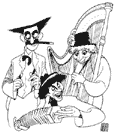 Hirschfeld's caricatures of the Marx Brothers defined their
look. After his posters for their 1935 movie, A Night at the Opera,
all other caricatures of the zany trio looked like Hirschfeld's.
Even the MGM make-up crew joined in, trying, in their second movie, A
Day at the Races, to make the brothers look like Hirschfeld's
drawings with Groucho's hair teased to resemble
the two triangles Hirschfeld gave him in his
caricature.
Hirschfeld's caricatures of the Marx Brothers defined their
look. After his posters for their 1935 movie, A Night at the Opera,
all other caricatures of the zany trio looked like Hirschfeld's.
Even the MGM make-up crew joined in, trying, in their second movie, A
Day at the Races, to make the brothers look like Hirschfeld's
drawings with Groucho's hair teased to resemble
the two triangles Hirschfeld gave him in his
caricature.
The Marx Brothers phenomenon was celebrity caricature in microcosm:
actors in those years were "glandular actors," Hirschfeld
said: "Every gesture is big and sweeping, and they're great to draw."
They were larger than life, hugely theatrical personalities, and so, logically,
they looked like their caricatures.
The Marx Brothers remained a favorite subject with Hirschfeld
all his life—including the penultimate day of it: his last drawing,
done on Saturday the 18th, was of the Marx Brothers, a private commission.
Hirschfeld realized that an aspect of the phenomenon of caricature
was that the subject could begin to look more like the drawing than he
looked like himself. Ray Bolger, actor and dancer extraordinaire, once
claimed that his stage appearance was copied from the artist's conception
of him.
Hirschfeld's first theatrical drawing was published, almost
accidentally, in the New York Herald Tribune on December 26, 1926,
and he contributed a drawing every week for the next dozen or so years.
For awhile during the thirties, he also indulged a social conscience,
drawing for The New Masses, a radical political magazine with Socialist
(if not Communist) ambitions.
He and the magazine came to a parting of the ways in a dispute
over the way he caricatured Father Charles Coughlin, a right-wing, anti-Semitic
radio priest, and Hirschfeld renounced political
cartooning: "I have ever since been closer to Groucho
Marx than Karl," he said.
Hirschfeld did not begin with the line for which he is now
so celebrated. But within
a year of his newspaper debut, it was in evidence.
Still, by his own account, it was not until he visited the South
Pacific island of Bali in 1931 that his love affair with line began in
earnest: on the island, the sun bleached out all
color, he said, "leaving everything in pure line." By the time he returned
to New York, he had abandoned painting to concentrate on black-and-white
pen-and-ink rendering. He gave up sculpting, too. "Sculpture," he once
said, "is a drawing you trip over in the dark."
Hirschfeld's early inspirations were Al Frueh
and Miguel Covarrubias. He shared a studio with
the latter in the early days, and it was Covarrubias,
Hirschfeld said, who demonstrated to him that caricatures
could be designs, abstract shapes arranged in telling configurations.
Barbra Steisand was birdlike in Hirschfeld's
drawing—all points, with a wide-open mouth and exotically lidded
eyes. Rotund Zero Mostel, drawn as Tevye
in "Fiddler on the Roof," was a circle of black beard and hair, fierce
eyes glowering up at a heaven that didn't comprehend. Phil Silvers was
all high forehead, enormous eyeglasses and a tiny curve for a mouth.
Although Hirschfeld claimed he left painting
behind, he didn't entirely: he used his pen like a brush, bringing his
magnificent line into being not with a single sweeping gesture but with
repeated short strokes, one after the other, going over and over the line
as he expanded and built it up.
In 1943, he married a noted European actress, Dolly Haas. The same
year, he agreed to do his theatrical drawings exclusively for the New
York Times. For the next sixty years, he did so, but he never had
a contract: he worked on a freelance basis and retained ownership of his
drawings, which, it is estimated, number in the vicinity of 7,000 (some
of which are on display at www.alhirschfeld.com).
His non-theatrical efforts—renditions of motion pictures,
television shows and personalities, politicians and other cultural effusions—were
published in virtually every magazine of any significance. Except,
strangely, The New Yorker. Strange because
Hirschfeld was the epitome of a New Yorker. We are
left to conclude that the magazine's notably eccentric and dictatorial
founding editor, Harold Ross, had been miffed by a visual prank Hirschfeld
played in 1937.
For Life magazine, Hirschfeld
produced a series of "photo-doodles," photographs that, with a few strokes
of his brush, the artist transformed into other personages. He turned
a photograph of Jimmy Durante into Al Smith, onetime governor of New York. To the
visage of the autocratic Ross, he affixed a moustache, converting him
into Joseph Stalin. He also transformed Mary Pickford
into Adolf Hitler, but the only one of his victims
who probably took offense was Ross. How else to account for Hirschfeld's
being banished from the magazine whose pages he was so obviously suited
to grace?
In recent years, though, Hirschfeld drawings
have cropped up in the magazine. At long last.
For much of his career, Hirschfeld's
artwork was controlled by Margo Feiden, whose
gallery had exclusive rights for the exhibition, sale and licensing of
his work. In 2000, however, he took her to court in order to assert his
right to determine without her consent when and where his creations could
be exhibited. He dropped the suit when they negotiated a new contract
by which he regained control of his art.
Hirschfeld drawings have been displayed in numerous museums—the
Metropolitan, the Museum of Modern Art, and the Whitney in Manhattan,
and art museums in Cambridge, St. Louis, and Cleveland, to name a few.
In Broadway's theaters, Hirschfeld was
a fixture on opening nights, sitting on the aisle, making cryptic sketches
unseen on a notepad concealed in his pocket—"a couple of huge eyes,"
he said in describing himself, "and a huge mattress" of white beard. "No
forehead," he continued; "the forehead that you see is just the hair disappearing."
"It was an honor to be drawn by him," actress Bernadette Peters
said. "He did his interpretation of your performance, and each time he
drew you, it was different, capturing what you did on stage."
After the play, Hirschfeld would go back
to his brownstone in the East 90s and convert his pocket notes into the
elegant drawing that would appear on Sunday. He famously sat at his drawingboard
on a barber's chair, which he liked, so the story 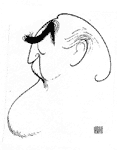 goes,
because he can raise and lower the seat to suit his body English. But after seeing one of the photographs
of him in one of the book compilations of his work, I suspect there's
yet another reason: you can tilt a barber's chair back into a nearly horizontal
position, perfect for a quick afternoon nap.
goes,
because he can raise and lower the seat to suit his body English. But after seeing one of the photographs
of him in one of the book compilations of his work, I suspect there's
yet another reason: you can tilt a barber's chair back into a nearly horizontal
position, perfect for a quick afternoon nap.
In 1945, momentarily in the grip of fatherly pride, he insinuated
into a drawing a little piece of mischief that would become a Sunday parlor
game for generations. To celebrate the birth of his daughter, he started
hiding the child's name, Nina, in his drawings, thereby inaugurating what
he calls the "national insanity" of readers' trying to count the number
of times the name appears, sometimes as strands of hair, sometimes as
folds in a shirt, sometimes in the filigree of a piece of jewelry, sometimes
all the above and more in a single drawing.
When he began the practice, he didn't think anyone would notice.
He regarded it as a private, family joke. But when he stopped doing it
after a few weeks, thinking the joke had run its course, letters poured
in.
"I found myself spending more time answering the mail than drawing,"
he said, "so I gave up and put it back in. And kept
it in."
Hirschfeld was finally persuaded to give his readers a hint:
next to his signature, he jotted the number of Ninas
in each picture. And the parlor game then consisted of finding as many
Ninas as he'd said were there. Once, asked by his editor to
find the five Ninas he alleged were in a drawing,
he was stumped, for a time, after finding four. When, at last, he found
the fifth, secreted in the folds of a fur coat, he exclaimed: "This could
drive a person crazy!"
In some quarters, Nina-hunting got serious. The U.S. Department
of Defense once used blow-ups of Hirschfeld
drawings projected on a screen as an exercise: 100 bomber pilots were
given 20 seconds to find the Ninas as training in target spotting.
"The art of caricature," Hirschfeld wrote
in the introduction to The World of Hirschfeld,
"or rather, the special branch of it that interests me,
is not necessarily one of malice. It is never my aim to destroy the play
or the actor by ridicule. . . . My contribution is to
take the character—created by the playwright and acted out by the
actor—and reinvent it for the reader."
Only once, he admitted, did he set out to portray a person unfavorably:
it was an ironic depiction of David Merrick, the producer, whom Hirschfeld
drew as a demonic Santa Claus. The picture yielded mixed results.
"I did everything I could to make him look bad," Hirschfeld
said, "and what happened? He bought the original from me and used it on
his Christmas card!"
Except for Santa Merrick, all Hirschfeld's
portraits have been affectionate. Playwright Arthur Miller's description
is apt:
"People in a Hirschfeld drawing all share
the one quality of energetic joy in life that they all wish they had in
reality. Looking at a Hirschfeld
drawing of yourself is the best thing for tired
blood. The sheer tactile vibrance of the lines and their magical relationships to each
other make you feel that all is not lost, that you still have a way to
go before bed, that life can be wonderful, that he has found a wit in
your miserable features that may yet lend you a style and a dash you were
never aware of in yourself.
"And he accomplishes these miracles because he serves his secret. In service to that secret, he makes us
all seem like a purposeful, even merry, band of vagabonds whose worst
features he has redeemed. . . . He
makes all these people look interesting . . . because they probably are
to him."
Although Hirschfeld is one of the most
articulate of artists, he claimed not to be able to explain some of the
phenomenon in what he does. Enchanted
by "line," he said that he'd tried to find out why it communicates and
how, but "I must say I'm no closer to finding a definition for it than
I was when I started. All I know is that when it works, I'm aware of it.
But how it's accomplished, I don't know.
"I come out of the theater with a lot of abstract little markings
that I then translate into line," he continued. "The important thing is
that the drawing look a little bit like the actor I'm drawing. There
is a lot of trial and error, and a lot of erasing until I can get it as
far as I can, before the final inking. It is not a pretty process.
"After 70 years of drawing," he went on, "you have to improve,
otherwise you are a dolt. You take a blank piece
of paper and create a problem that didn't exist before and then you solve
it to your best satisfaction. It is a question of elimination and understanding,
of trial and error, and suddenly something happens, an epiphany. I'll
look at it and say to myself, "Did I do that?'"
His deference notwithstanding, his discussion of caricature is
illuminating.
"I try to capture the character of the play or the individual rather
than making a caricature for caricature's sake," he said. "Making a big
nose bigger isn't witty."
It's not just a matter of exaggeration, he insisted. (And any one of us who dabbles in caricature
knows that is true.) By way
of explaining, Hirschfeld once talked about
how we all can recognize acquaintances from long distances. They may be dressed differently than we've
ever seen them, but we still recognize them. Something about the way they hold themselves,
their heads, arms; something about the way they move.
We all have this ability to recognize others.
"I don't know what happens there," Hirschfeld
said, "but it has nothing to do with anatomy, surely. You can't tell whether he has a big nose
or a small nose, big ears or small ears. . . . So what communicates?
"My talent," he concluded, "is to take what exists in everyone—that
talent for recognition—and make it palpable to the reader. . . . How this is done, I don't have a clue.
I don't know any more about it now than when I started except that,
I say, it's the same thing of recognition.
I sometimes slave over a drawing, erasing and erasing, and then
eliminating and eliminating, and suddenly something on the paper registers
with me, and I say, "Hey—that's it!
That looks like him!' When it works, occasionally, people see the
same thing as I see."
I've never read a better description—however much this one
seems to be groping—of what a caricaturist aims for.
He aims to make others recognize the familiar in what he draws,
and he does it by mysterious alchemy, partly by exaggerating but mostly
by making recognizable a somewhat abstracted picture of his subject.
Both his profession and the nation have bestowed honors on Hirschfeld,
particularly in the last decade or so. The National Cartoonists Society
gave him the Milton Caniff Lifetime Achievement
Award in 1996.
In 1975, he received a special Tony, an Antoinette Perry Award,
signaling that the theater world welcomed him not only as an observer
but as one of its own, and in 1984, he was the first recipient of the
Brooks Atkinson Award.
In 1991, the U.S. Postal Service issued a series of stamps bearing
Hirschfeld's caricatures of comedians; and in 1994, he did
another series of silent film stars. And if you saved the folder that
the former came in, you have a collector's item: no other stamp booklet
has had the artist's name on the cover.
In 1996, Susan Dryfoos produced a videotape,
"The Line King," which tells "The Al Hirschfeld
Story" and also lets us see him at work, stroking that impeccable line
into being.
The ultimate honor for the stage-struck artist came last fall when
it was announced that on his 100th birthday, next June 21st, the Martin
Beck Theater on West 45th would be renamed the Al Hirschfeld
Theater. It will be the first time a Broadway theater has been named after
a visual artist.
And on the Friday before he died, according to Louise Kerz,
an arts historian he married in 1996 two years after Dolly Haas died,
Hirschfeld received word that he had been elected to the American
Academy of Arts and Letters. On the same day, the White House told him
he would be one of the recipients of the National Medal of the Arts. Hirschfeld was undoubtedly pleased, but he said only, "If
you live long enough, everything happens."
Hirschfeld's drawings have been collected in several books—including
The World of Hirschfeld, The American Theatre as Seen by Hirschfeld,
and Hirschfeld: Art and Recollections from
Eight Decades. Perhaps the most engaging is the recent Hirschfeld
On Line (1999), which includes comments by
the artist on every drawing.
He both illustrated and wrote a light-hearted primer of the entertainment
world, Show Business Is No Business. It is the first Hirschfeld
book I ever owned, and even though he wrote it, I've never read it. I
look at the pictures, which include scores that are not caricatures of
celebrities but pictures of imaginary showbiz denizens.
Another cast of imaginary Hirschfeld
characters illustrates Garson Kanin's Runyonesque
Do Re Mi, a fictional expose of the "jukebox gangland world." But
in The Lively Years: 1920-1973 by theater critic
Brooks Atkinson, theatrical caricatures abound. And all of the members
of the famed Algonquin Roundtable appear under Hirschfeld's
pen in Margaret Case Harriman's The Vicious Circle.
He collaborated with humorist S.J. Perelman on several projects,
including a travel series of articles for Holiday magazine subsequently
published as a book, Westward Ha! Around the World in 80 Cliches,
and a musical, "Sweet Bye and Bye," which opened
and closed on the same night in Philadelphia. Other joint enterprises
with Perelman include The Swiss Family Perelman and Listen to
the Mocking Bird.
Hirschfeld once compared drawing and writing for publication:
"The artist has a much better, easier chance editorially to express
himself than a writer," he said. "I've seen at the Times an editor
taking an article by Winston Churchill, who is a great prose writer, and
edit it. Scratch out things,
rearrange sentences, cut out whole paragraphs, cross things out. As I'm watching, I'm saying, "You know
if you ever did that with a drawing, you'd be garroted; no artist would
allow you to do that.'
"They may not accept the drawing . . . but they would never take
a pencil and rearrange the face and turn it the other way or add something
to it. They have more respect for drawings than
they have for writing, apparently."
Here, here.
It is widely accepted in show business, as Gelb said, that "you
haven't arrived until you've been drawn by Al."
Many coveted the drawing as well as the accolade. Hirschfeld
did a full-color caricature of Liberace for the cover of Collier's
in 1954. Liberace wanted to obtain the painting,
his agent said in a letter to the characterist,
and when Hirschfeld replied by quoting a price,
the agent fired off a furious response, saying that Liberace owned many
paintings of himself done by famous artists, none of whom had ever asked
for payment.
Hirschfeld wrote back, apologizing for the misunderstanding
and his seeming ingratitude. "I
promised faithfully to dispatch the original painting to Mr. Liberace
posthaste without payment of any kind, to hang in his living room," Hirschfeld
continued, "—on one condition—that you send me Mr. Liberace
to hang in mine."
For most of this century, Hirschfeld's
pen-and-ink players—some with stars twinkling for eyes, others with
whirling pinwheels or blind squints or starkly staring dots—gesticulated
extravagantly with tentacle fingers at the end of elastic arms and loped
or swirled joyfully across the front page of the theater section or just
loitered there. Either way, they created a visual chronicle of American
show business in the 20th century, both catalogue and history.
After a play closes, often all that is left of it for the record
are a handful of newspaper reviews—and Hirschfeld's
drawing. Every public document should be so delightfully witty and affectionate,
benignly perceptive as well as amusing.
Click on the thumbnails below to view gallery images:
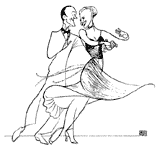 |
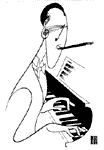 |
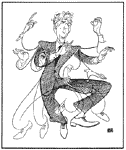 |
 |
 |
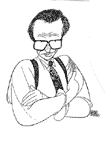 |
 |
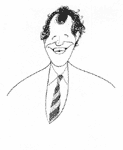 |
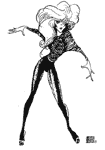 |
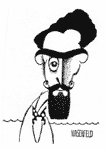 |
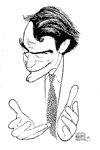 |
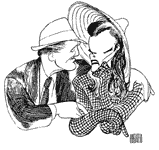 |
